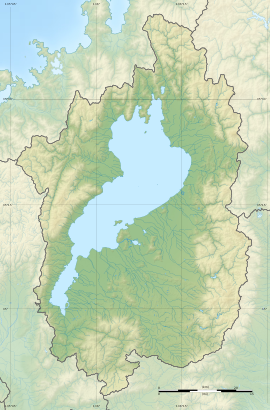| Azuchi Castle | |
|---|---|
安土城 | |
| Azuchi, Ōmi province, Japan | |
 Painting of Azuchi Castle (by Iwasaki Ōu, 1855) | |
| Coordinates | 35°09′22″N 136°08′22″E / 35.156022°N 136.139361°E |
| Type | Azuchi-Momoyama castle |
| Height | Seven stories (138ft)(main keep) |
| Site information | |
| Controlled by | Oda clan |
| Condition | Stone base remains |
| Site history | |
| Built | 1579 |
| Built by | Oda Nobunaga |
| Materials | stone, wood plaster walls |
| Demolished | 1582 |
| Events | Azuchi religious debate (1579) |
| Garrison information | |
| Garrison | 5,000 (incl. civilians) |
Azuchi Castle (安土城, Azuchi-jō) was one of the primary castles of Oda Nobunaga located in the Azuchi neighborhood of the city of Ōmihachiman, Shiga Prefecture. The site of the castle was designated a National Historic Site in 1926, with the designation upgraded to that of a Special National Historic Site in 1952.[1] The castle is located within the grounds of the Biwako Quasi-National Park.
Azuchi Castle was built from 1576 to 1579 on Mount Azuchi on the eastern shore of Lake Biwa in Ōmi Province.[2] Nobunaga intentionally built Azuchi Castle close enough to Kyoto that he could watch over and guard the approaches to the capital, but outside Kyoto so his fortress would be immune to the fires and conflicts that occasionally consumed the city. Azuchi Castle's location was also strategically advantageous in managing the communications and transportation routes between Nobunaga's greatest foes – the Uesugi to the north, the Takeda in the east, and the Mōri to the west.[3] Azuchi Castle was demolished in 1582 by Akechi Mitsuhide after his assassination of Nobunaga in the Honno-ji Incident.
Many researchers agree that Azuchi Castle was the catalyst for the establishment of early modern castles in Japan from the Azuchi–Momoyama period onwards. Yamajiro (山城, lit. 'Hill castles') of the Sengoku period were, so to speak, earthen fortresses built by cutting through the mountain and heaped up with rocks and earth, with military priority, but Nobunaga's stone castles were a revolutionary departure from these, and became show castles with both political functions.[4]
The Azuchi-Momoyama period of Japanese history partially takes its name from Azuchi Castle.
- ^ "安土城跡" [Azuchi-jō ato] (in Japanese). Agency for Cultural Affairs. Retrieved August 20, 2021.
- ^ Hinago, Motoo (1986). Japanese Castles. Kodansha International Ltd. and Shibundo. p. 17,28,118–121. ISBN 0870117661.
- ^ Ōrui, N. and M. Toba (1935). Castles in Japan. Tokyo: Board of Tourist Industry & Japan Government Railways.
- ^ "安土城は何が画期的だったのか 研究者の間で続く「争論」とは" [What was groundbreaking about Azuchi Castle? What is the continuing controversy among researchers?]. Kyoto Shimbun (in Japanese). Kyoto. 3 April 2021. Retrieved 9 August 2023.

